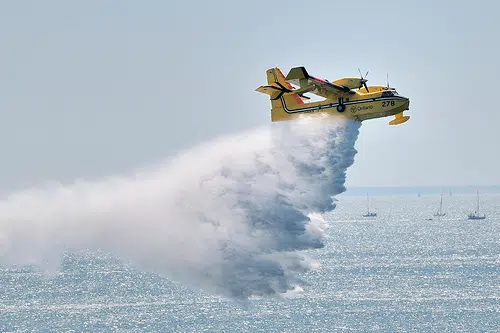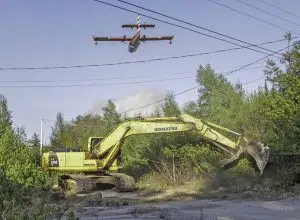
Photo courtesy MNR Aviation, Forest Fire and Emergency Services
After the devastating wildfires that displaced hundreds in Nova Scotia last week, people are starting to ask if it is time for the province to invest in our own fleet of firefighting aircraft.
One counsellor for the Halifax Regional Municipality, Pam Lovelace, said she is focused on making sure wildfires can’t impact residents as severely as we just saw. Her district of Tantallon/Hammonds Plains had 151 homes damaged or destroyed by the nearly 1,000-hectare wildfire that tore through it.
“I’m focused on ensuring that this never happens again and looking at ways that we, as a municipality, can have the tools that we need, which clearly is air support for these wildland forest fires,” said Lovelace.
Michael Benson is the director of business development for Conair Aerial Firefighting. He has been fighting wildfires for 30 years now both from the air and on the ground. He has spent most of his career in British Columbia where aerial supports use a combined attack of water skimmers and land based airtankers to suppress wildfires.
Water skimmers, or waterbombers as they are sometimes called, are what we saw deployed in in Nova Scotia to combat our wildfires. They are designed to skim along bodies of water to collect water which they then drop directly on the fire.
“The purpose there is to reduce the intensity of the fire. And these this aircraft type works really quite well in those areas that have an abundance of water bodies nearby,” said Benson.
“It’s really critical that those water bodies be nearby to the fire because the water doesn’t last very long, so it’s important that you have a fairly continuous flow of water to be able to make headway on holding the fire.”

A waterbomber flies over an excavator working on the Barrington Lake Wildfire last week. (Photo Credit: Communications Nova Scotia).
Land based airtankers look more like standard commercial airplanes that you can see at your local airport. Except, their outfitted with a massive tank along their bellies that carry retardant to be dropped around the perimeter of the fire. Benson says they work well in unison with water skimmers to slow the fire from spreading with ground crews work to build a perimeter around the fire and contain it.
“The aircraft themselves aren’t extinguishing the fire. They’re really trying to hold it and contain it to buy time for those ground resources… they’re the ones that actually end up extinguishing the fire,” said Benson.
He said that placing retardant around a wildfire typically can buy crews on the ground around four hours to contain the fire.
With the unprecedented start to fire season in not just Nova Scotia but across Canada, Benson says every agency should be reviewing their ability to respond to wildfires. He says that securing an aerial fleet is a big step in improving how quickly and efficiently agencies can contain a fire.
“I would say many agencies would benefit from having an aerial firefighting fleet, and many agencies throughout Canada are actually reviewing their fleets right now and recognizing that fire seasons are getting longer, fire seasons are getting more intense, and the resources that they have traditionally, been using are no longer sufficient to be able to meet the need,” said Benson.
Throughout last week, Nova Scotia brought in help from waterbombers across North America. Quebec, Newfoundland and Labrador, and Montana all sent planes to help put out the largest and most destructive fires in the province’s history.
Without their help, who knows how big the fires could have got.





Comments